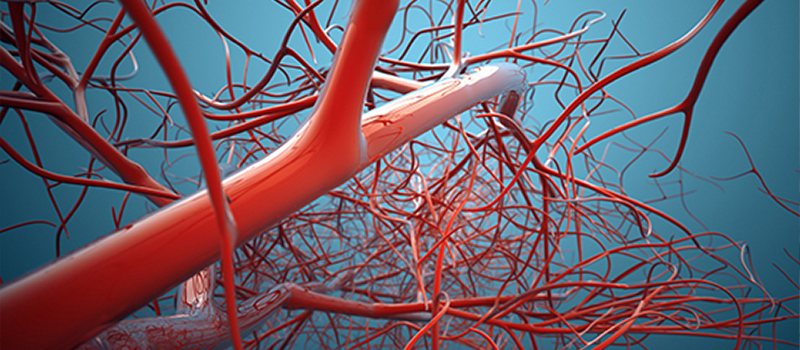Vascular disease is the term used to describe any disease that affects the vascular system. This includes diseases of the arteries, veins, and capillaries. Arteries are blood vessels that carry
oxygen-rich blood away from the heart to all parts of the body. Veins are blood vessels that return oxygen-poor blood to the heart. Capillaries are small blood vessels connecting arteries and veins
to allow for direct communication between them.

Common Types of Vascular Disease
Vascular disease interrupts blood or oxygen flow to an organ or other tissue in the body.
Aneurysms, heart attacks, blood clots, and peripheral artery disease are all examples of vascular diseases.
Lymphedema: Lymphedema is a severe and chronic condition that causes inflammation, swelling, and fluid accumulation in the tissues. It occurs when the lymphatic system becomes blocked or damaged. One of the most common causes is surgery or trauma to an arm or leg.
PAD: Peripheral artery disease (PAD) is a condition where blockages in the arteries of the limbs restrict blood flow. This can cause pain and will make it harder for afflicted limbs to function
properly.
Aortic Aneurysm: Aortic aneurysms are the most common type of vascular disease. They happen when the aorta (the main artery carrying blood to your organs) becomes enlarged and bulges out. It may be caused by damage to the existing wall or by the sudden weakening of the artery wall due
to infection or clogged blood vessels.
Blood clots: Blood clots can be a danger for those who have vascular disease. Clots that form in the blood vessels may cause serious problems. The clot can reduce or completely cut off blood
flow in the affected area, leading to severe pain and tissue death.
Venous Disease: Venous disease refers to any disease of the veins, which are the vessels that carry blood from the body back to the heart. This can be caused by various environmental factors, including standing or sitting still for long periods. Venous disease affects an estimated 10-20% of people in “westernized” societies.
Fibromuscular Dysplasia (FMD): Fibromuscular Dysplasia is a condition of the vascular system, and it is caused by damage to the artery’s tunica intima and muscularis externa. The disease is more prevalent in females than males, and it occurs most often in people between ages 30 to 50.

Common Symptoms of Vascular Disease
The most common symptom of vascular disease include:
• Pain or numbness in the extremities and tingling in the hands
• Numbness in fingers or toes
• Difficulty climbing stairs
• Leg cramps at night
• Bruising easily
• A loss of height or height loss over time
• Fatigue/ weakness
The signs of vascular disease are often difficult to notice because they are gradual.
Treatment
The treatment for the vascular disease can be affected by several factors. These include the type and severity of the vascular disease, the person’s lifestyle, and also other medical conditions that they may have. The treatments for vascular diseases include medication and surgery.
A person will often be prescribed medications as their first line of treatment, as these usually work
well initially to reduce symptoms such as pain or muscle cramps. However, if the medication does not work, surgery may be necessary to address the underlying problem with veins or arteries to restore blood flow and correct any blockages.
At Washington Vascular Specialists, you can expect knowledgeable healthcare professionals dedicated to helping you succeed with your treatment. Call 301-891-2500 to book an appointment.



